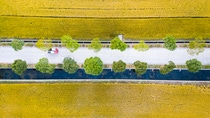Newsletter Resins & Additives for Coatings
From sustainable forestry to product carbon footprint

The German term “Nachhaltigkeit” ‒ “sustainability” in English ‒ has its origins in forestry. Mining counselor Hans Carl von Carlowitz first used the word “Nachhaltigkeit” in 1713 in his publication on the “sustainable use” of forests. This concept entails practices such as the replacement of all trees that are felled.
You can only cut down as many trees as can be regrown.
More than 250 years later, in 1987, the World Commission on Environment and Development (WCED or Brundtland Commission), established by the United Nations in 1983, coined the term “sustainable development”.
BASF introduced the concept of eco-efficiency in the early 1990s as a response to growing concerns about sustainability and the need to balance economic growth with environmental considerations. BASF’s eco-efficiency analysis is a methodology designed to measure the environmental impact and economic performance of its products and processes.
Since conducting its first eco-efficiency analysis in 1996, BASF has continuously refined and expanded the methodology. The analysis covers the whole life cycle of a product from raw material extraction to disposal and assesses the environmental impacts associated with each stage.
Eco-efficiency analysis encompasses the entire life cycle of a product.
It also takes account of the economic costs and benefits of different alternatives. BASF was one of the first companies in the chemical industry to establish such a method.
BASF’s eco-efficiency analysis provides a quantitative framework for decision-making, allowing the company to identify areas where improvements can reduce environmental impacts and increase resource efficiency. By integrating sustainability considerations into its business processes, BASF aims to create value both for the company and for society as a whole.
A further milestone is BASF’s SEEbalance® concept, its Socio-Eco-Efficiency Analysis developed in 2005. SEEbalance®, which is used to evaluate and compare different product and process alternatives, includes economic, environmental, and societal aspects of sustainability.
By incorporating more complex factors, the SEEbalance® concept broadens the perspective. However, public discussion in recent years has increasingly narrowed down. While the amount of CO2 released by a product, measured as product carbon footprint (PCF), is undoubtedly important, the SEEbalance® concept allows for other crucial factors that are often overlooked.
Partnerships for product carbon footprint methodology
BASF has made a strong commitment to achieving net zero greenhouse gas emissions by 2050, aligning with the goals of the Paris Agreement and implementing various strategies to reduce emissions across its value chain. The identification of reduction potential is crucial to steering the decrease of greenhouse gas emissions toward net zero. Gaining transparency with carbon footprint at product level is an indispensable precondition for the achievement of this goal.
We have developed a digital solution for efficient calculation of product-related, cradle-to-gate carbon footprints (PCF) using primary data and, when necessary, secondary data from databases. Our solution enables us not only to provide accurate and granular PCFs for our sales portfolio, but also creates unparalleled transparency in what is driving greenhouse carbon emissions in our manufacturing footprint and raw material purchasing basket.

Product carbon footprint refers to the total greenhouse gas emissions produced throughout the life cycle of a product. It includes emissions from raw material extraction, manufacturing, transportation, use, and disposal. The carbon footprint is typically measured in carbon dioxide equivalent per kg of product (CO2e) and is used to assess the environmental impact of a product. Calculating and reducing the product carbon footprint can help companies and consumers make more sustainable choices and mitigate climate change.
An internationally recognized framework is a prerequisite for decarbonization.
Another important step was an agreement by the chemical industry on how to calculate the product carbon footprint. The methodology provides a standardized, internationally recognized framework. “By applying the PCF Guideline, TfS [Together for Sustainability] members and their suppliers can holistically approach the integration of PCFs of chemical products within their corporate greenhouse gas (GHG) inventories, with a focus on Scope 3 Category 1 (purchased goods and services) emissions. The comprehensive guideline advises companies on how to calculate their own corporate inventories on the basis of supplier-specific data, while at the same time providing guidance on how to calculate the PCFs of their own chemical products, with the aim to create transparency and decarbonize the entire value chain. The PCF calculated will support downstream users for their calculations as well.”
Source: “The Product Carbon Footprint Guideline for the Chemical Industry”, issued by Together for Sustainability, version 2.1, page 2, February 2024.
To download the guideline, please follow the link: https://www.tfs-initiative.com/how-we-do-it/scope-3-ghg-emissions/pcf-guideline
| Product Name | Laromer® LR 8986 | Laromer® LR 8986 MB |
| Calculation date | 25.06.2024 | 01.07.2024 |
| Sum of partial PCFs (kg CO2 e/kg) | 3.4 | 1.2 |
| Partial PCF fossil (kg CO2 e/kg) | 3.4 | 3.5 |
| Partial PCF biogenic (kg CO2 e/kg) | 0.0 | -2.3 |
| Biogenic carbon in product (kg biogenic C/kg) | 0.0 | 0.63 |
| Total carbon content in product (kg C/kg) | 0.64 | 0.63 |
| Raw material data quality | good | good |
PCF data of Laromer® LR 8986 and Laromer® LR 8986 MB calculated by our digital tool according to the methodology described in the article.
Via the BMB approach the PCF of Laromer® LR 8986 can be reduced by 65%*
BASF provides PCF data for all products in accordance with this guideline. This allows our customers to select products based on a low carbon footprint and reduce their own Scope 3 emissions.